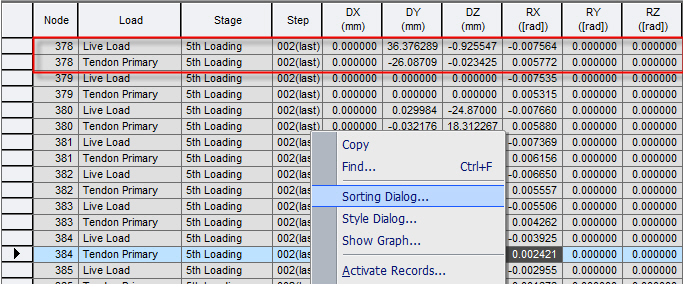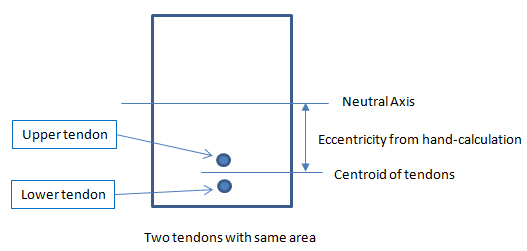Beam Diagrams
Check Shear Force Diagram (SFD) and Bending Moment Diagram (BMD) for beam elements.
From the Main Menu select Results > Results > Forces > Beam Diagrams.
 Load Cases/Combinations
Load Cases/Combinations
Select a desired load case, load combination or envelope case.
The
Construction Stage applicable for the output of the construction
stage analysis is defined in Select Construction Stage for Display
or Stage Toolbar. Click ![]() to the
right to enter new or modify existing load combinations. (Refer
to "Load
Cases / Combinations")
to the
right to enter new or modify existing load combinations. (Refer
to "Load
Cases / Combinations")
Note
When results are produced in max, min and all in such cases as
moving loads, support settlements, time history analysis and Envelope
load combinations, selecting "all" produces beam diagrams
displayed in absolute values of member forces irrespective of
the signs of member forces. In order to produce beam diagrams
reflecting the signs, check on "Consider Signs in Load Combination
Type of Envelop "all" of Tools>Preference>Environment>Results.
Step
Specify the step for which the analysis results are to be produced.
The Step is defined in geometric nonlinear analysis as Load Step,
and additional steps are defined in the construction stages of
bridges or heat of hydration analyses.
Note
The Construction Stage applicable for the output of the construction
stage analysis is defined in Select
Construction Stage for Display or Stage Toolbar.
Max/Min
Diagram
Absolute maximum values of Envelope can be checked in Beam Diagram.
Note
1. If Envelope/all is selected, 'Max/Min Diagram' becomes activated.
If the option is unchecked, a Diagram with absolute maximum
values of Envelope is generated.
2. [Moving load analysis to AASHTO LRFD] When midas Civil envelops maximum and minimum results, two design truck scenario is considered for the negative moment and reaction only. In other words, although the maximum shear or axial force effects are found under two truck loading, midas Civil will disregard them and present the force effects from a single truck scenario. For example, if a single truck results in the maximum axial force -240 kips and double trucks result in the maximum axial force of -450 kips, midas Civil will report -240 kips in the min/max envelope results.
|
 Type of Display
Type of Display
Define the type of display as follows:
Contour |
Display the member forces of beam elements in contour. |
|
Ranges: Define the contour ranges.
Note Number of Colors: Assign
the number of colors to be included in the contour (select
among 6, 12, 18, 24 colors) Colors: Assign or control the colors of the contour. Color Table: Assign the type of Colors.
Reverse Contour: Check on to reverse the sequence of color variation in the contour. Contour Line: Assign the boundary line color of the contour Element Edge: Assign
the color of element edges while displaying the contour Contour Options: Specify options for contour representation Contour Fill Gradient Fill : Display
color gradient (shading) in the contour. Draw Contour Line Only Mono line: Display the boundaries of the contour in a mono color. Contour Annotation Spacing: Specify the spacing of the legend or annotation. Coarse Contour (faster)
(for large plate or solid model) Extrude |
Deform |
Display the deformed shape of the model. |
|
Deformation
Scale Factor Deformation
Type Nodal Deform : Display
the deformed shape reflecting only the nodal displacements. Real Displacement (Auto-Scale off): The true deformation of the structure is graphically represented without magnifying or reducing it. This option is typically used for geometric nonlinear analysis reflecting large displacement. Relative Displacement: The deformation of the structure is graphically represented relative to the minimum nodal displacement, which is set to "0" |
Values |
Display the
member forces of beam elements in numerical values. |
|
Decimal
Points : Assign decimal points for the displayed
numbers Min & Max: Display
the maximum and minimum values Set Orientation: Display orientation of numerical values Note |
Legend |
Display various references related to analysis results to the right or left of the working window. |
|
Legend Position: Position of the legend in the display window Rank Value Type: Specify a type of values in the Legend and the number of decimal points. |
Animate |
Dynamically
simulate the member forces of beam elements. |
|
Animation Mode: Determine the type of animation for analysis results. Animate Contour: Option
to change the color of the contour representing the transition
according to the magnitudes of variation Note AVI Options: Enter the options required to produce animation window. Bits per Pixel: Number
of bits per pixel to create the default window for animation Construction Stage Option: Select the animation options when the construction stage analysis is performed. Stage Animation: Animations
by construction stages |
Undeformed |
Overlap the undeformed and deformed shapes of the model. |
Mirrored |
"Mirrored" allows the user to expand the analysis results obtained from a half or quarter model into the results for the full model by reflecting planes. |
|
Half Model Mirroring |
Quick View |
Display the Beam Force Detail Diagram for an element in a separate window.
|
|
Element: Enter an element number for which the member forces are generated. Or click the entry field and the relevant element in the Model View. Load Case: Select a desired load case or load combination. Select Load/Step/Comp. Step: Specify the step for which the analysis results are to be generated. Component: Select a desired member force component. Result Value Display the member forces at I-End & J-End, and maximum & minimum values of the selected element. Value: Move the mouse cursor in the diagram to display member forces at the corresponding position. Total Length: Display the length of the element. |
 Output Section Location
Output Section Location
Assign the section locations at which member forces of the beam elements are produced in numerical values.
I: Display the member force at the start node (N1) of a beam element.
Center: Display the member force at the center of a beam element.
J: Display the member force at the end node (N2) of a beam element.
Abs Max: Maximum absolute values of member forces among the 5 points of (4-sectioned) beam elements are displayed at the centers of the beam elements.
Min/Max: Minimum and maximum member forces are numerically displayed at the corresponding locations among the 5 points of (4-sectioned) beam elements.
All: The member forces at the i-end, center and j-end are numerically displayed.
 Batch Output Generation (
Batch Output Generation ( .jpg) ,
,
.jpg) )
)
Given the types of analysis results for Graphic outputs, generate consecutively graphic outputs for selected load cases and combinations. A total number of files equal to the products of the numbers of checked items in the three columns of the dialog box below are created.
|
Assign a Base File Name under which the types of results (selection data in the Batch Output Generation dialog box for graphic outputs) are stored. |
|
Specify the Base Files to perform Batch Output Generation, construction stages, load cases (combinations), steps, etc. in the following dialog box. |
Saved Menu-Bar Info's: Listed here are the Base Files. Select the Base File Names for Batch Output.
![]() : Delete all the
Base Files selected with the mouse.
: Delete all the
Base Files selected with the mouse.
When the construction stage analysis is carried out, all the construction stages are listed. We simply select the stages of interests to be included in the batch output. If no construction stage analysis is performed, the column in the dialog box becomes inactive and lists load (combination) conditions.
Stages
The results output of all the construction stages are produced.
The construction stages are listed below.
Final Stage Loads
The results output for only the Final Stage are produced. The construction
stages are listed below. If no construction stage analysis is
performed, the load (combination) conditions are listed.
Use Saved
Apply only the (saved) step or load (combination) condition selected
at the time of creating each Base File.
Stage LCase/LComb
When the construction stage analysis is carried out, the auto-generated
construction stage load conditions and the additionally entered
construction stage load combinations are listed. Check on only
the load (combination) conditions that will be used to produce
batch outputs. This column becomes inactive if "Final Stage
Loads" is selected or no construction stage analysis is carried
out.
Step Option
Specify the steps for which the outputs will be produced when the
construction stage analysis or large displacement geometric nonlinear
analysis is performed.
Saved Step: Use only the steps used for creating the Base Files
All Steps: Use all the steps
Output Options
Output File Type
Select a Graphic File type, either BMP or EMF.
Auto Description:
At the top left of the Graphic Outputs produced in batch, auto-generate
and include the notes such as the types and components of the
analysis results, construction stages and steps, load (combination)
conditions, etc. The font size, color, type, etc. can be changed
upon clicking the button ![]() .
.
Output Path
Specify the path for saving the graphic files to be produced in
batch.
File Prefix: Specify the prefix of the Graphic Files to be created. The filenames will be consisted of "Prefix"_"Base File Name"_"Load Comb.".bmp(emf) or "Prefix"_"Base File Name"_"Stage"_"Stage LCase"_"Step".bmp(emf).
![]() : Produce the specified
batch Graphic Files reflecting the contents of the dialog box.
: Produce the specified
batch Graphic Files reflecting the contents of the dialog box.
![]() /
/ ![]()
Produce
the contents of data input in the Base Files and Batch Output
Generation dialog box in a binary type file (fn.bog). Click the
![]() button and select
a fn.bog to use the same output format.
button and select
a fn.bog to use the same output format.
Note
Import /Export is only meaningful for different projects. In a
given structural model, the Base Files are automatically stored
and listed.
![]() Revision
of Civil 2015 (v1.1)
Revision
of Civil 2015 (v1.1)
Q1. How can I obtain the results for the summation of CS:Live Load and CS:Tendon Primary only?


